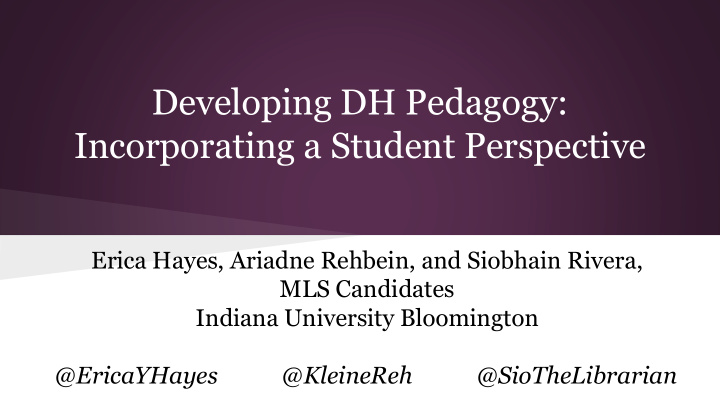



Developing DH Pedagogy: Incorporating a Student Perspective Erica Hayes, Ariadne Rehbein, and Siobhain Rivera, MLS Candidates Indiana University Bloomington @EricaYHayes @KleineReh @SioTheLibrarian
Outline ● DH Research vs. DH Pedagogy ● Purpose and Goals of our Study ● About Our Study ● DH Instructor Interviews ● Student Survey Results ● Tips & Advice
DH Research vs. DH Pedagogy “Out of a corpus of 297,399 words [in Blackwell's Companion to Digital Humanities ] ‘research’ occurs 504 times, whereas ‘teaching’ and ‘pedagogy’ occur 66 and 8 times respectively… I refer to the almost systematic relegation of the word “teaching” (or it’s synonyms) to the status of an afterthought...” - Brett Hirsch , Digital Humanities Pedagogy
Purpose and Goals of our Study Discover: ● What do students want from DH courses? ● Are students gaining what they need through DH courses? ● What pedagogical practices in DH courses best enable students to achieve their goals? Provide: ● Mutual understanding and greater dialogue between instructors and students ● Practical tips for improving course design and meeting learning objectives
“Digital Humanities is such an over-extended term--there is not a general understanding of what we are preparing students for. Are we preparing students for digital humanities center work or technology jobs? There might be an identity crisis on what a Digital Humanities class is and what it is going to do for students. Students don’t know what to expect or what it is going to do for them. ” - Amanda Gailey, University of Nebraska, Lincoln
About our Study ● 10 DH instructor interviews ● 75 DH student survey responses from undergraduate and graduate students at 25+ institutions ● Self-identification of DH - no definition of DH provided
DH Instructor Interviews Key Points: ● It is important to teach students digital literacy ● No one course can teach the entire spectrum of DH ● Ideally 50/50 split between lab and theory ● Professional skills: Group work and collaboration ● Learning technology: failure-based learning and getting your feet wet ● Projects that allow students to gain practical skills and explore their research interests
DH Student Surveys Questions we asked: ● What was your experience with DH before this class? ● How would you describe your technology skills? How comfortable are you with learning new technology? ● What technologies did you use? How did you use them? ● What were the best and worst things about the course? ● What advice would you give the instructor?
Things That Worked ● Final research project with a technology application that reflects real working conditions ● Community building: within the classroom and with larger DH community ● Balance experimentation/creativity with faculty support/guidance and clear goals/expectations
Things That Didn’t Work ● Survey courses that cover too much material - too many tools in too little time ● Emphasis on theory rather than practical and creative application of technologies ● Open-ended projects without specific guidelines
With which department was your class affiliated?
Previous DH Experience
“I was aware that the thing called "digital humanities" was "trendy" and therefore a wise career move, but hadn't encountered any DH research that seemed compelling. ” -Student respondent
“Meaningful experience working on digital projects (in interdisciplinary teams) is what makes digital humanities graduates so attractive and this is what employers are looking for. This is professionalization that does not run the risk of being narrowly focused on a particular job category. This is professionalization that prepares students for academic and para- academic positions. ” -Geoffrey Rockwell and Stefan Sinclair “Acculturation and the Digital Humanities Community"
Technology Skills: Before & After
Comfort with Learning New Technology: Before and After
What Technologies Did You Use?
How did you use these technologies?
Student-centered Tips & Advice ● Develop professional skills to be competitive in the job market ● Foster collaboration among peers to build project management skills and gain experience working with diverse groups ● Design class projects that allow students to explore their research interests ● Focus more on productive applications of technology tools ● Invite guest lecturers and encourage networking/engagement with DH scholars in the field ● Define concrete goals and expectations for the course
Tips & Advice for DH Course Design ● Build a series of courses that span multiple semesters ○ Each course focuses on one or two technologies ● Devote more time and add extra credit hours ○ Teach DH like a foreign language or science class with a lab component for technology training ● Include practicum-style courses that allow real-world projects
Thank you Erica Hayes @EricaYHayes Ariadne Rehbein @KleineReh Siobhain Rivera @SioTheLibrarian dhpedagogystudy@gmail.com
Recommend
More recommend